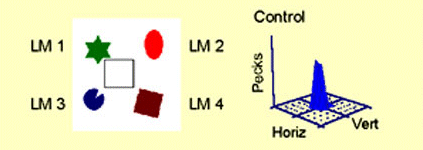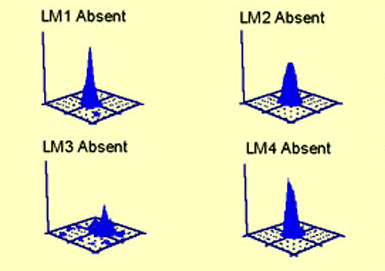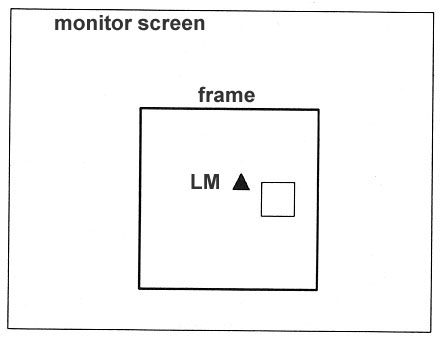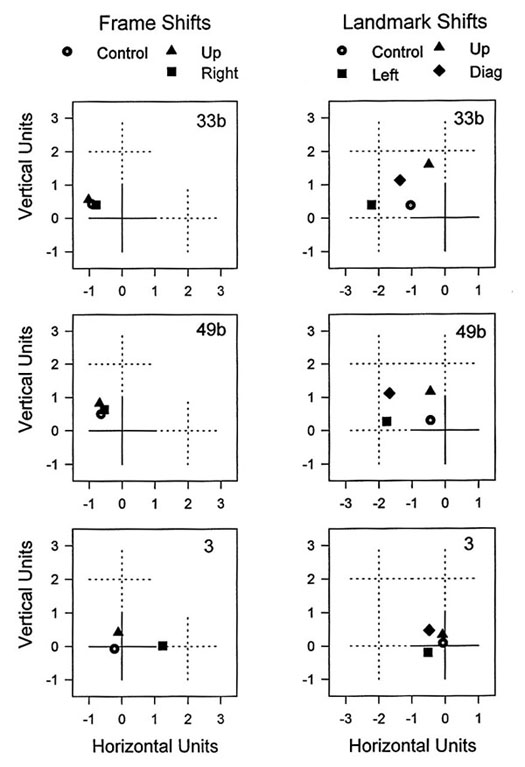Cheng
& Spetch
Homepage
Next Section:
Independent
averaging of
distance and
direction
__________
|
IV. Selective Stimulus Control
Sometimes, when multiple cues may be used to do a task, a pigeon may
nevertheless use a subset of cues. For instance in Reynold's (1961) experiments, pigeons could make a discrimination
between two stimuli on the basis of two different stimulus dimensions (object
shape or background color). One pigeon relied most on shape, while the
other pigeon relied most on color. The
same is also true when pigeons use landmarks for localization. The first
example below is from a study by Spetch
& Mondloch (1993).
|
Training Phase
|
|
 |
The bird whose data are shown below was trained on the touch screen
to search at the location indicated by the square in the left side panel. The location of the entire configuration of landmarks on the monitor
shifted from trial to trial, so that the array was the only valid predictor
of the target location. After preliminary training, the target location was not marked in any
way. The right panel shows that this pigeon was good at localizing the hidden
square.
|
|
|
Transformation Test Phase
|
|

|
On different tests, one of the landmarks was
removed from the display. The figure above show that
this particular bird's performance markedly deteriorated when LM3 was absent,
but was good whenever LM3 was present and the other landmarks was absent. The results indicate that the bird relied most on LM3 for
its landmark-based
search for the hidden target.
|
|
The next example is from an experiment by Cheng & Spetch, (1995).
|
Training Phase |
|
 |
In this experiment, pigeons were trained to search on the touch
screen with the above array. Again, the entire array was shifted about the touch screen from trial
to trial. Again, the target (smallest square) was not marked after preliminary
training.
|
|
|
Transformation Test Phase |
|

|
Following this training, tests in which the frame or the landmark (LM)
were shifted were done. The data shown above show the peak places of searching.
The target location on control tests is indicated by the intersection
of the solid lines.The intersections of the dotted lines show the hypothetical target
locations according to the shifted frame or landmark.The performance of individual birds indicated that birds 33b and 49b
shifted their place of searching most when the landmark was moved, while
bird 3 shifted most when the frame was moved. Thus, birds 33b and 49b seemed to rely most on the landmark for localization,
while bird 3 relied most on the frame. Selective stimulus control in using landmarks has also been found with
pigeons using digitized images of objects presented on a monitor (Spetch
& Wilkie, 1994).
|
|
Selective stimulus control in landmark use seems to be the opposite of
averaging the dictates of different landmarks. In this case, one or a subset
of landmarks dominate completely. But given that averaging does sometimes
take place, it is best to think of selective stimulus control as averaging
with extreme weights, namely a weight near 1 for the landmark relied on,
and weights near 0 for the ignored landmarks. In this way, selective stimulus
control and averaging differ in parametric settings, and not qualitatively.
A single account in terms of weighted averaging handles both cases.
Next Section: Independent
averaging of distance and direction
|

